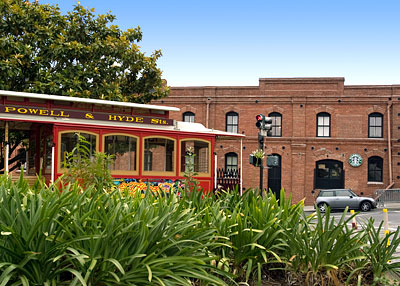San Francisco Landmarks
Haslett Warehouse
680 Beach Street
Built 1907
Located near the Powell Street Cable Car terminus, Aquatic Park, and Fisherman's Wharf, the building now known as the Haslett Warehouse was commissioned by the California Fruit Canner's Association at the same time as the adjacent Cannery building and was built in 1907-1909.
Until 1936, peaches, asparagus, peas, cherries, tomatoes and apricots were brought to San Francisco by riverboat and ferry from the interior valleys of California. After processing on the Cannery assembly line, they were shuttled across the street via a short railroad line for storage here while awaiting distribution.
When the company merged in 1916 with three other canners to form the California Packing Company, foods bore the Del Monte label.
By 1936, California Packing had moved its canning operations to the East Bay closer to its rural labor pool and to the transportation facilities which would speed its goods to outlets back east. California Packing Company then converted the former Cannery into a warehouse, and from 1937-1948, both the Cannery and the present Haslett Warehouse served as storage space for the company's goods.
The building was purchased in 1948 by the Haslett Warehouse Company, a leader in the warehouse business in San Francisco since 1878, to expand its chain of sixteen warehouses.
Over the years the warehouse has sheltered many unusual items. From 1930 to 1943, the numbered and disassembled pieces of an Italian monastery acquired by William Randolph Hearst, were stored here before being transferred to another waiting post behind the Japanese Tea Garden in Golden Gate Park.
Shortly after World War II, Haslett Warehouse was a mortuary. Bodies of deceased Chinese bound for burial in their homeland rested in the warehouse until brokers determined that a full cargo load could depart for China.
The warehouse was also used to store imported automobiles, tires and, until 1948, numerous items from China. [Difficult to believe that there was a time, not too long ago, when the United States did not trade with Communist China!]
In 1963, the Haslett Company sold the warehouse to the State of California for conversion to a Railroad and Locomotive Museum, but the conversion was never realized.
Source: Adapted from City Planning Commission Resolution 7075 dated September 20, 1973.

The Haslett Warehouse was designed by architect, William S. Mooser, Jr., who also designed many of the buildings in nearby Ghirardelli Square. (Mooser's father designed the Pioneer Woolen Mills in Ghirardelli Square.)
Mooser, Jr. would later become San Francisco's first City Architect and chief of the first Bureau of Buildings, where he oversaw the drafting of the first San Francisco building code and the issuance of the first building permits.

The Haslett Warehouse is also National Register Listing 75000172.
